#both are strong bonds but the difference in dynamic is fundamental to why one functions arguably better than the other
Explore tagged Tumblr posts
Text
steve was searching for the man bucky was and sam looks at the man he is
#both are strong bonds but the difference in dynamic is fundamental to why one functions arguably better than the other#also sam has no expectations of bucky for who he should be or what he should remember because he didn’t know bucky pre serum#captain america#the falcon#the winter soldier#steve rogers#sam wilson#bucky barnes#stucky#sambucky#marvel#mcu
113 notes
·
View notes
Note
On your comments about Jack: ye-es, in the sense that Jack is a character who definitely deserved better than he was treated by the characters. The way Dean especially treats him reflects very badly on Dean, no question. But, speaking as a viewer, I think the perspective needs to shift a little bit.
To me, Jack is Dawn from Buffy, or Scrappy Doo. He’s an (in my opinion) irritating kid who is introduced out of nowhere to be both super vulnerable and super OP, and the jeopardy is centered around him in a way that has nothing to do with his actual character or relationships. He’s mostly around to be cute and to solve or create problems — he never has any firm character arcs or goals of his own, nor any deeper purpose in the meta narrative. In this way, he’s a miss for SPN, which focuses heavily on conflicts as metaphors for real life.
Mary fits so much better in that framework, and introducing her as a developed, flawed person works really well with the narrative. It is easy for us to care about Mary, both as the dead perfect mother on the pedestal and as the flawed, human woman who could not live up to her sons’ expectations. That connection is built into the core of SPN, and was developed over years, even before she was a character. When she was added, she was given depth and nuance organically, and treated as a flawed, complex character rather than as a plot device or a contrivance. She was given a voice and independence, and became a powerful metaphor for developing new understandings of our parents in adulthood, as well as an interesting and well-rounded character. You care that she’s dead, not just because Sam and Dean are sad, but for the loss of her development and the potential she offered. So, in that sense, I think a lot of people were frustrated that she died essentially fridged for a second time, and especially in service of the arc of a weaker character.
And like, you’re right, no one can figure out if Jack is a toddler or a teenager. He’s both and he’s neither, because he’s never anything consistently and his character arc is always “whatever the plot needs it to be.” Every episode is different. Is he Dean’s sunny opportunity to be a parent and make up for his dad’s shitty parenting? Yes! Is he also Dean’s worst failure and a reminder that he has done many horrible things, including to “innocent” children? Yes! Is he Cas’s child? Yes! Is he Dean’s child? Yes! But also, no! Is he Sam’s child? Yes! Is he a lonely teenager who does terrible things? Yes! Is he a totally innocent little lamb who doesn’t get why what he is doing is wrong? Yes! Is he the most powerful being in the universe? Yes! Does he need everyone to take care of him? Yes! Is he just along for the ride? Yes! Is he responsible for his actions? Kinda??? Sometimes??? What is he???
Mary as a character is narratively cohesive and fleshed-out. Jack is a mishmash of confusing whatever’s that all add up to a frustrating plot device with no consistent traits to latch on to. Everything that fans like about him (cute outfits, gender play, well-developed parental bonds with the characters) is fanon. So, yes, the narrative prioritizes Mary. Many fans prioritize Mary, at least enough that Dean’s most heinous acts barely register. To the narrative (not to Cas, which is a totally different situation), Jack is only barely more of a character than Emma Winchester, who Sam killed without uproar seasons earlier. He’s been around longer, but he’s equally not really real.
I debated on responding to this because, to tell the truth, I think we fundamentally disagree on a number of subjects and, as they say, true insanity is arguing with anyone on the internet. However, you spent a lot of time on the above and I feel it's only fair to say my thoughts, even if I don't believe it will sway you any more than what you said changed my opinions.
I'm assuming this was in response to this post regarding how Jack's accidental killing of Mary was treated so severely by the brothers, particularly Dean, because it was Mary and, had it been a random character like the security guard in 13x06, it would have been treated far differently. However, then the argument becomes less about the reaction of the Winchester brothers to this incident and more the value of Jack or Mary to the audience.
I believe we need to first admit that both characters are inherently archetypes—Mary as the Madonna character initially then, later, as a metaphor for how imperfect and truly human our parents are compared to the idol we have as children, and Jack as the overpowered child who is a Jesus allegory by the end. Both have a function within the story to serve the Winchester brothers, through whose lens and with whose biases we are meant to view the show's events. We also need to admit that the writers didn't think more than a season ahead for either character, especially since it wasn't initially supposed to be Mary that came back at the end of season 11 but John, and they only wrote enough for Jack in season 13 to gauge whether or not the audience would want him to continue on or if he needed to be killed off by the end of the season. Now, I know we curate our own experiences online which leads to us being in our own fandom echo chambers, however it is important to note that the character was immediately successful enough with the general audience that, after his first episode or two, he was basically guaranteed a longer future on the show.
I have to admit, I’m not entirely sure why the perspective of how his character is processed by some audience members versus others has any bearing on the argument that he deserved to be treated better overall by the other characters especially when taking their own previous actions in mind. I’m not going to tell you that your opinion is wrong regarding your feelings for Jack. It’s your opinion and you’re entitled to it, it harms no one to have it and express it. My feelings on Jack are clearly very different from your own, but this is really just two different people who processed a fictional person in different ways. I personally believe he has a purpose in the Winchesters’ story, including Castiel’s, as he reflects certain aspects of all of them, gives them a way to explore their own histories through a different perspective, and changes the overall dynamic of Team Free Will from “soldiers in arms” to a family (Misha’s words). In the beginning he allows Sam to work through his past as the “freak” and powerful, dangerous boy wonder destined to bring hell on earth. With Dean, his presence lets Dean work through his issues with John and asks whether he will let history repeat itself or if he’ll work to break the cycle. Regarding Cas, in my opinion he helps the angel reach his “final form” of a father, member of a family, lover and protector of humanity, rebellious son, and the true show of free will.
From strictly the story, he has several arcs that work within themes explored in Supernatural, such as the argument of nature versus nurture, the question of what we’re willing to give up in order to protect something or someone else and how ends justify the means, and the struggle between feeling helpless and powerless versus the corruptive nature of having too much power and the dangerous lack of a moral compass. His goals are mentioned and on display throughout his stint on the show, ones that are truly relatable to some viewers: the strong desire to belong��the need for family and what you’ll do to find and keep it.
With Mary, we first need to establish whether the two versions of her were a writing flaw due to the constant change in who was dictating her story and her relationship to the boys, which goes against the idea that her characterization was cohesive and fleshed-out but, rather, put together when needed for convenience, or if they both exist because, as stated above, we are seeing the show primarily through the biased lens of the Winchester brothers and come to face facts about the true Mary as they do. Like I said in my previous post, I don’t dislike Mary and I don’t blame her for her death (either one). However, I do have a hard time seeing her as a more nuanced, fleshed-out character than Jack. True, a lot of her problems are more adult in nature considering she has to struggle with losing her sons’ formative years and meeting them as whole adults she knows almost nothing about, all because of a choice she made before they were born.
However, her personal struggles being more “mature” in nature (as they center primarily on parental battles) doesn’t necessarily mean her story has layers and Jack’s does not. They are entirely different but sometimes interconnected in a way that adds to both of their arcs, like Mary taking Jack on as an adoptive son which gives her the moments of parenting she lost with Sam and Dean, and Jack having Mary as a parental figure who understands and supports him gives him that sense of belonging he had just been struggling with to the point of running away while he is also given the chance to show “even monsters can do good”.
I’d also argue that Jack being many ages at once isn’t poor writing so much as a metaphor for how, even if you’re forced to grow up fast, that doesn’t mean you’re a fully equipped adult. I don’t want to speak for anyone else, but I believe Jack simultaneously taking a lot of responsibility and constantly trying to prove to others he’s useful while having childish moments is relatable to some who were forced to play an adult role at a young age. He proves a number of times that he doesn’t need everyone to take care of him, but he also has limited life experience and, as such, will make some mistakes while he’s also being a valuable member of the group. Jack constantly exists on a fine line in multiple respects. Some may see that as a writing flaw but it is who the character was conceived to be: the balance between nature or nurture, between good and evil, between savior and devil.
Now, I was also frustrated Mary was “fridged” for a second time. It really provided no other purpose than to give the brothers more man pain to further the plot along. However, this can exist while also acknowledging that the way it happened and the subsequent fallout for Jack was also unnecessary and a sign of blatant hypocrisy from Dean, primarily, and Sam.
And, yes, Jack can be different things at once because, I mean, can’t we all? If Mary can be both the perfect mother and the flawed, independent, distant parent, can’t Jack be the sweet kid who helps his father-figures process their own feelings on fatherhood while also being a lost young-adult forcing them to face their failures? Both characters contain multitudes because, I mean, we all do.
I can provide articles or posts on Jack’s characterization and popularity along with Mary’s if needed, but for now I think this is a long enough ramble on my thoughts and feelings. I’m happy to discuss more, my messenger is always open for (polite) discussion. Until then, I’m going to leave it at we maybe agree to disagree.
#long post#long ask#so long answer#guys it's 1 am#i hope this made sense#watch me read this after sleep and register things i wish i said#oh well#jack kline#mary winchester#spn#supernatural#spn critical#supernatural critical#kinda?#eh just in case#spn meta#supernatural meta#jack meta
27 notes
·
View notes
Text
Something I don’t think I’ve ever seen explored but that could be a possibly interesting subversion of the common conception that Dick is Bruce’s favorite, even according to his other children:
What if the things they viewed as favoritism were really just overcompensation? For instance, when Dick and Bruce started being presences in each other’s lives again after Tim became Robin, it was a gradual thing, they only slowly kind of got used to being around each other again over time. As I’ve often said in the past, my big gripe about this, and why I so intensely dislike all of that being framed as Tim being a catalyst for reuniting them, is its precisely BECAUSE of how it all played out that way, that Bruce....never actually needed to apologize or make amends to Dick or even ASK for him to come back....which compounded the fact that he’d never really ever gotten around to doing all of that because of the conflict between them for other reasons before Jason’s death happened.
And I do think a lot of that has to do with Bruce’s tendencies towards self-flagellation, though this doesn’t excuse it. I honestly do believe that it’d be perfectly in character if the reason Bruce never apologized for all that even then was because he didn’t think what he’d done WAS forgivable, so it felt....false to him, to try and ask for forgiveness. What this fails to consider though, is that apologizing, making amends, TRYING to make up for what you did to the other person.....its not about WHETHER or not they forgive you, or think they can.
Its simply about acknowledging wrong and harm done, and saying....you’re sorry. You regret it. You know it was a mistake and that you can’t take it back, but you just want them to know you’re....not unaware of the harm you caused.
After that, yeah, the ball is in their court, but if you never actually put that out there, how are they ever supposed to truly KNOW that you know that? Believe that?
How can people ever be asked or expected to grant forgiveness when its so commonly depicted as though for the people who hurt them, even just ASKING for it is harder than it must be for the people who WERE hurt to GRANT it?
But Bruce is very much someone who believes that actions speak louder than words, so I could see someone taking the angle that he tries to EXPRESS his regret to Dick in other ways, through various actions and behaviors with or around him.....which could be construed to others in the family as displays of favoritism....
Because they’d have no way or any reason to think of them as attempts at amends or expressions of regret, like they would, say, if any of those similar behaviors were exhibited around Jason - whether they were accepted by Jason or brushed off. Point being, they would GET that this was what it was with Jason, because they’re all aware Jason is angry at Bruce for very specific things, with most of them being aware what MOST of those things are (definitely not counting the ending of UTRH).
(And just pointing out here again for emphasis since its not like I tack it on as a qualifier in all my posts, but I honestly hate how frequently various parts of fandom decide one character or another is Bruce’s favorite or worse, that this is OKAY, like its not a fundamental problem if he definitively has a favorite. Of course that creates divides in a family. To me, ideally, a healthy Batfam has no favorites, they just have members of the family who are more favorite to them in SOME ways than in others.
For instance, I also dislike the idea that Damian is Dick’s favorite, but I don’t think the closeness of their relationship is threatened or mitigated by acknowledging that the bonds between Dick and his other siblings are just as strong, just in different ways. That its ‘special’ with Damian in a way it isn’t with the others because of how close they got that year Dick practically raised him, that makes the nature of their relationship different. But its equally ‘special’ with Jason, because Jason was Dick’s FIRST brother, they were each other’s first family beyond just parental figures, there’s a significance to that which doesn’t just go away, and still neither of those undervalues the fact that Tim and Dick spent years being close as the only two brothers, who had only each other and Bruce, and Bruce sometimes being emotionally or even physically unavailable to turn to making it that much more necessary for them to turn to each other, essentially, between Jason’s death and return and even after Cass became a presence in their lives, due to her usually going to Babs for the kinds of things Dick and Tim would work through together, and then of course Cass is Dick’s only sister which puts her in another category altogether, not better or worse, its simply that Cass is neither Dick’s brother nor was she ever a Robin so they have a relationship that for example, whatever else it consists of, will never be defined or threatened by any of the issues that have plagued the family when it comes to the Robin succession. And Duke and Dick’s dynamic of course is still basically just whatever the hell you individually decide it to be because hahahaha what if you wrote them interacting for more than like, one issue only, DC HMMM?
Point being - FUCK family favorites. The whole idea is stupid and toxic and IMO fundamentally incompatible with an actual healthy, functional Batfamily, so it kinda blows my mind when I see people UPHOLDING the idea of this character being so and so’s favorite or everyone knows Dick is Bruce’s favorite and Jason is Alfred’s favorite and Damian is Dick’s favorite....no. Why. Stop that. They can all be special to each other in entirely different ways for entirely different reasons. Family is not a zero sum game. And none of this means that there aren’t some of them who just GET ALONG better than they do with the others at sometimes, or like these two just tend to have more fun with each other, or this is who this one usually goes to when this happens, etc. There’s nothing wrong with that, that’s good, it just means.....things are different between different members of the family. That doesn’t have to equal FAVORITES though. Favorite to share this particular activity with? Sure. OVERALL though? Miss me).
ANYWAY.
Detour aside and circling back to my point.....say for instance the other kids see Bruce appear to be making an effort with Jason, singling him out for praise or acknowledgment....its not hard for them to imagine reasons WHY Bruce might be doing that, which don’t automatically equate to an insecure conviction that Bruce just loves Jason more than them and he’s his favorite....because there are other explanations, other reasons why Bruce might feel a need to act differently with Jason than he does with the rest of them, things unique to their dynamic. Similarly, say for instance Bruce is written making a particular effort with Damian to acknowledge him - there’s lots more angles to spin it as than just favoritism, they had a very rocky start everyone in the family is aware of, so its more likely to just read as like....Bruce making more of an effort where its already understandable to everyone else that an effort is merited.
And Bruce HAS admittedly at different times been written as very clearly making an effort and being a good father to his kids, like, the capacity has always been there of course. But there were ‘good times’ with Bruce and Jason, with Bruce and Dick, with Bruce and Tim, etc, etc. So when the effort being seen comes paired with an understandable or apparent GAP the others are aware of.....the effort is easily seen as nothing more than BRIDGING the already existant gap, rather than....advancing that one particular child AHEAD of the others.
So much of the conflict between Bruce and Dick during Jason’s time as Robin stemmed from the fact that.....there was a huge, existing gap between Bruce and Dick even BEFORE Bruce took Jason in....and there was no effort made by Bruce during that time to bridge that gap. And then Bruce took Jason in, adopted him, made him Robin....STILL while making no attempt to reach out to Dick, make amends, bridge the gap he was steadily INCREASING between both boys and their respective relationships with him....so y’know, its kinda hard NOT to see or at least understandably imagine favoritism from Dick’s POV there....
BUT, its also easy to imagine why from the other kids’ perspectives, Dick might be Bruce’s favorite or the one he’s closest with, and its not because he’s perfect or the original or anything like that, but rather just....time.
Quite simply, Dick is the one kid Bruce spent the most time with, before any of the others joined the family. He spent a good eight years growing up in the manor, Bruce’s only family other than Alfred. Its quite easy and understandable to imagine from the perspective of the ones who came later, this would translate into more closeness, more ease and familiarity, even more respect, more love......because that thing that they each have with Bruce to some degree, that makes them family, the time spent with him, the comfort or praise they’ve received from him, purely in an empirical sense, in terms of rough numbers if nothing else, Dick has had more of it. Bruce has given more of it.
Of course they’re resentful or assume they can’t measure up, in light of that. How can the mere two or three years some of them have had as Bruce’s family compete with the eight Dick had and that’s even just before any of the others came along at all.
So they look at Bruce making an effort with Dick, the way he doesn’t always do with them, they see Bruce making a point to acknowledge Dick or praise him or express he’s putting his faith in him - all the things they’re all eager to hear - and the easiest and most obvious conclusion to draw when asking themselves “why is he like that with Dick, but not with me, or at least never as much”....is that its because of that essential element Dick and Bruce’s relationship has that none of the others do.....time.
The problem is, of course.....they don’t have the whole perspective, and they’re drawing conclusions without paying proper consideration to all the possible alternatives.
Because yes, Bruce and Dick’s relationship has had more time to encompass so many of the good moments and the positives between them......but the reverse is equally true. Its had that much more time to encompass the bad moments and the negatives in their relationship as well. And this is part of the narrative trap created when not focusing on or even just acknowledging the downs of Dick and Bruce’s relationship, specifically where the burden of responsibility is on Bruce.....because it sets up a quandary - “Bruce often behaves differently with Dick than he does with his other children” - but only allows certain interpretations to be read in as possible explanations for this.
So the second you lock in the take that Bruce’s relationship with Dick has never really HAD any low moments because Dick wasn’t fired, they weren’t estranged for years (though cough cough, what’s your explanation for Bruce’s absence from major defining stories of Dick’s at the time where he really could have used some comfort or support from Bruce, like the Church of Blood or Titans Hunt BUT I DIGRESS), and NTT #55 certainly didn’t happen, then its like.....you’ve reduced the intricacies of their dynamic and past history down to only its fundamental positives, and as such are only really showcasing Bruce being more positive than not with Dick while layering in the impression that this is the way its always been.....
And not only are you giving cause to the other children looking at this dynamic and seeing only one possible explanation - whether or not its just because they’ve spent more time together, Dick is Bruce’s favorite and always will be - you’re also creating the inevitability that Dick pretty much MUST be written as equally positive towards Bruce at all times - aka appearing as the loyal footsoldier his siblings often accuse him of being, particularly when they’re having their own conflicts with Bruce and Dick is defending him - OR if you write Dick as behaving negatively towards Bruce or making complaints of his own against Bruce....who in the eyes of all the others, clearly already favors Dick more than them as is.....it makes Dick look like a spoiled, ungrateful asshole who can’t even appreciate the fact that Bruce already loves and respects him more than he does any of them, like nothing will ever be good enough for him.
Basically, as is a fairly common theme for me, lol, my point is that I think a lot of the more negative and two-dimensional portrayals of Dick in fandom come not even from writers innately or initially seeing HIM that way....but rather are just a symptom of the corners many often write themselves into simply by REFUSING to write other characters in certain negative ways....without paying consideration to the ripple effects this would have on the dynamic between both characters overall. And then more readers and fans internalize these negative and two-dimensional portrayals of Dick and add them or have them feed into their own predispositions towards any of the other characters aside from him, and it kinda creates and perpetuates this whole self-sustaining cycle, where Dick so often becomes the ‘bad guy’ in family conflicts purely because writers won’t LET anyone ELSE ever be even just more responsible for a conflict with him.
But the second you put back even just ONE of the elements often cut out from Bruce and Dick’s relationship in support of Bruce, whether its firing Dick, not trying to make amends with him the whole time Jason lived with Bruce, the scene between them after Jason’s death......
Suddenly, you’ve got another explanation for why Bruce might be making MORE of an effort with Dick at times, to show he appreciates him, loves him, is proud of him.....because Bruce fucked up, and he doesn’t know how to fix it. And this is his awkward way of trying to show and not tell, because he doesn’t think the telling is ever going to be good enough, and its not even that Dick’s too petty or spiteful to ever accept Bruce’s apology, its that because its never taken the form of an ACTUAL apology, an ACTUAL acknowledgment of wrongdoing and an attempt to make amends.....its more likely Dick not seeing it for what it is on Bruce’s part is just Dick not wanting to set himself up for more disappointment, figuring he might be reading more into it than is actually there just because he WANTS to believe its an apology of some sort, he WANTS to forgive Bruce and get back at least some of what they lost over the years.
And meanwhile, from all the other kids’ perspectives, they see Bruce clearly making SOME kind of an effort with Dick that he doesn’t always make with them, and that when he does, usually its paired with something in their mind that makes it read as “oh that’s why he’s behaving this way” rather than “oh, clearly, this is proof I am The Favored One,”...BUT having access to only parts of the picture and no clue about a lot of the rest, working off of limited evidence, there’s no real way for them TO draw the correct conclusion....that this is Bruce trying to make RIGHT something that went WRONG.....not Bruce just lavishing Dick with praise and respect and recognition any of them would kill for and he seems to get for no reason....other than the obvious one....Dick’s the first, the original, the one who has a decade headstart on all of us in Bruce’s eyes and who we thus will never be able to catch up to so why try, hey, we should totally just, stab Caesar.
176 notes
·
View notes
Note
Hi! How are you doing? Not sure if it's already been asked, but what are your top 10 favourite canon couples?
Hello!
I am doing fine, thank you! How are you doing?
It is alright, nobody has asked this before, so I can answer! That said, I am not really a hardcore shipper, so I am not sure I will come up with 10 pairs :’‘‘). I’ll do my best though! Also I have interpreted the term “canon” very freely.
As usual, here they are in no particular order:
1) Claire Stanfield and Chane Laforet (Baccano!):

I love their dynamic because they are fundamentally two almost opposite individuals who end up together in a surprising way. On one hand Claire thinks that he is the protagonist not only of his own story, but of the whole world. As a matter of fact he believes that the world is nothing more than a dream of his. Ironically, it is because of this selfish delusion that Claire is able to embrace the whole world:
“So what if I'd spare him? In my mind it's the certainty in myself that I possess which allows me to have that kind of mercy or compassion. There's no wavering on that point. It's fixed like the stars. The fact is I'm never gonna be killed! So remember this: mercy and compassion are virtues that only the strong are privileged to possess. And I am strong.”
On the other hand Chane has chosen to be nothing more than her father’s puppet. She is a satellite character in her own life and can’t absolutely think to live as a protagonist. If Claire’s world is too big, Chane’s too little because it has only her and her father in it. What is more, Chane has gone out of her way to make sure that it stays that way. For example, she asked her father to take her voice away and has not learnt alternative ways to communicate (like sign language).
Given this premise, it is interesting that a person so self-centered like Claire puts a person with such a frail sense of self like Chane at the centre of his world. Claire makes Chane, who is not even the lead of her own story, the heroine of his huge world. Claire instead plays a support role in Chane’s story. It is precisely because of this contradiction that their dynamic works. All in all Chane gets to get in contact with the world through Claire. Because of this, she is challenged to grow. This is another interesting difference between them. On one hand Claire is basically like Peter Pan and can’t really grow psychologically. On the other hand Chane is a character who has changed, but who is scared of this change. This is why she tries to actively regress, but she can’t really go back to who she was.
2) Komugi and Meruem (HxH):

I have explained here what I love about them. Their relationship conveys the themes of the chimera ants arc beautifully. I especially like it because it would have been easy to have Meruem grow fond of Komugi because of her kindness and goodness. However, this is not really what happens. The reason why Meruem is so attracted by Komugi is her prowess as a Gungi player. Komugi is not a character who coddles Meruem, but one who challenges him. As a result Meruem’s attraction for her is rooted in respect. Meruem brings out from Komugi her talent and stubborness, while Komugi brings out from him his caring and kind side. Meruem becomes interested in her because of the traits they share and grows to love what makes her different from him.
3) Ash Lynx and Eiji Okumura (Banana Fish):
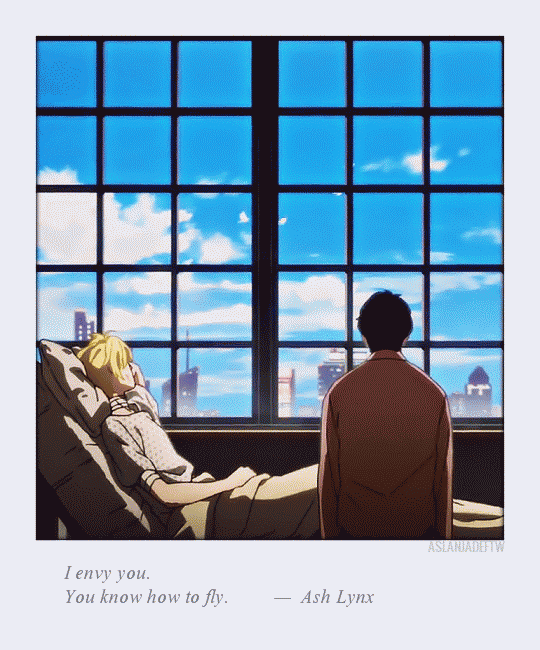
I like their relationship, but I would have loved for it to be explored even more throughout the story. All in all, they are attracted to each other because they want something the other has. Eiji wants Ash’s initiative and daring personality, while Ash wants Eiji’s freedom and soothing personality. Eiji wants Ash’s ability to fight for himself, while Ash wants Eiji’s talent to heal others instead of hurting them.
Despite this, they are not fully able to grow as they could have because of the violence of the conflict they are in. Eiji makes some steps in the right direction, but the moment a wound incapacitates him he goes back to his more passive behaviour. When it comes to Ash, he is not able to take fligth like he would like because of self-hate. Their ending is tragic, but I wonder if it could have been different. For example, after a meaningful conflict the two of them decide to avoid fighting and to simply enjoy the time they spend together. This is a relatable choice, but a series of things are left unexpressed and because of this they are not really able to overcome their flaws. Maybe, if they had fought a little more and had called each other out more, things could have been different in the end.
4) Claire Nunez and Jim Lake Jr (Tales of Arcadia):
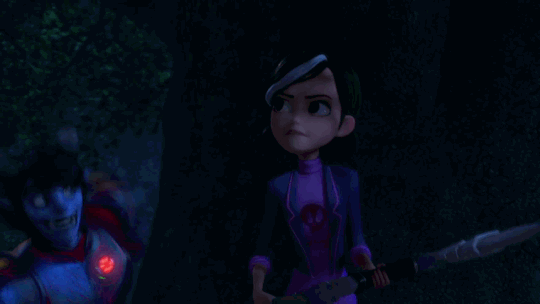
I have talked about them here. They are two very similar people to the point that they have basically the same flaw. They both feel responsible for bad things happening to them and to their friends. This is why they end up trying to fix everything by their own and fail spectacularly. It is nice to see them find help and support by their loved ones. And it is heart-warming that they keep being there for each other.
5) Chidi Anagonye and Eleanor Shellstrop (The Good Place):
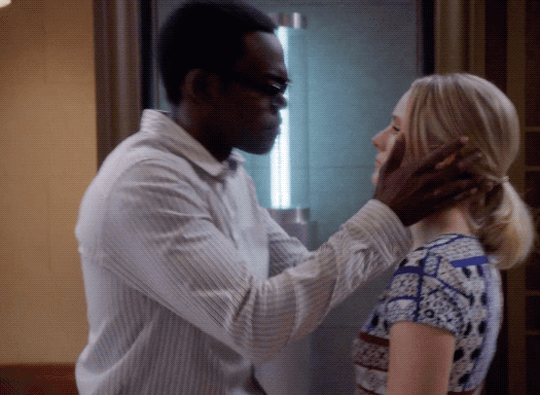
Eleanor and Chidi are completely different people and this is why they are perfect to challenge each other. Chidi inspires Eleanor to be more selfless and to open up to others, while Eleanor inspires Chidi to be daring. This is obvious since season 1 and it is a constant throughout the series. Their relationship is a good example of a relationship which is conflictual, but enriching. In order to stay together they (other than escaping hell) must overcome their respective flaws. Eleanor must be vulnerable and let Chidi in her life, while Chidi must be decisive and actively choose Eleanor.
I also like that this is true even in those timelines where they do not develop a romantic relationship. The fact that their relationship is the same, but also slightly differs in each reboot makes it gain a very nice thematic meaning and enriches it. All in all, what Chidi and Eleanor represent for each other is always the same and what changes is the platonic/romantic aspect of the bond.
Finally I like the motif of them leaving messages to their future selves about the other. At the end of season 1, Eleanor writes to herself: “Find Chidi”, while at the end of season 3 Chidi writes to himself: “Eleanor is the answer”. This is a very cool motif which conveys their respective growth thanks to the other. Eleanor who only trusts herself chooses to trust Chidi’s ability to help her. Chidi who has spent his whole life searching for answers and failing to write them down decides that Eleanor is all he needs to find meaning in his life.
6) Roy Mustang and Riza Hawkeye:

Their relationship is my favourite of the whole series. Their characters are beautifully intertwined to the point that they can barely function without the other. This aspect of their bond is not excessively romanticized, but it is presented as a dreadful consequence of the traumatic past they share. At the end of the day Roy and Riza are too highly idealistic people whose ideals were shattered before they could evolve in something more than childish dreams. Despite this, they were able to put the fragments of those great dreams back together and have chosen to sacrifice their personal happiness to realize them.
All in all, Riza and Roy want redemption for their crimes and they find comfort in each other while they try to obtain it. In order to make things better they are ready to sacrifice their own existences and they have given up on the chance of living normal lives as civilians. However, they still have each other.
Roy gives Riza someone to protect, so that she does not fall apart and remains functional, while Riza restrains Roy’s most negative instincts. They make each other better even if they can’t completely overcome the pain of their past. They can just share it with the other.
Finally I especially like the scene where Roy chooses not to transmute humans even if it means Riza will most likely die. As a matter of fact, despite it all, that act is not framed as a betrayal of Riza, but rather as the only thing he can do not to betray her. I love both relationships where a character fixated on an ideal lets go of it because of people and relationships which make a person realize the importance of an ideal. They are both beautiful when well written. Here we are in front of a bond where both aspects are present. On one hand Roy must let go of his desire of vengeance not to lose Riza. On the other hand Roy must let go of Riza not to betray the ideals they share.
In the end theirs is a very tragic and strict relationship, but also a very warm and human one.
7) Kokomi Teruhashi and Saiki Kusuo (Saiki Q):
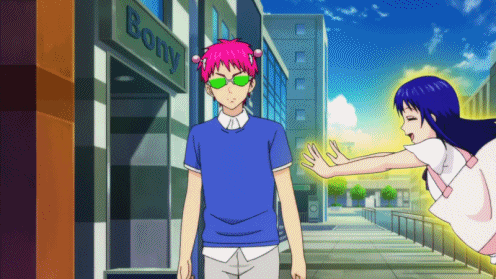
They are not properly canon since they are not together by the end. However, I think there is enough in the series to support the ship. Anyway, it is still a ship I enjoy a lot (and it is one of the few I feel strongly for, so I am adding it to the list no matter what).
I love their dynamic because it is hilarious, but it could also be surprisingly deep if the narrative wanted to explore it more. Teruhashi is my favourite character of the series because she is a nice subversion of both the yamato nadeshiko trope and of the alpha bitch one. She presents herself as an incredibly beautiful and yet innocent girl, but she is actually very aware of her looks and of others’ reactions. Despite this, she comes along as likeable mostly because she often genuinelly means well despite her being self-centered. Saiki instead projects the image of an average person, but he is actually the most powerful being of the world. In short, Teruhashi and Saiki are both opposite and the same.
They are the same because they both wear a carefully crafted mask. They are opposite because the masks they were are opposite. On one hand Teruhashi’s mask of the perfect girl attracts attention. On the other hand Saiki’s mask of the average guy is meant to make him invisible.
The difference between their two personas is the reason why Saiki wants to avoid Teruhashi at all costs. He wants to be average, so he can’t stay close to a person who attracts so much attention. At the same time, it is clear that Saiki grows to admire Teruhashi specifically because of her ability to always keep her mask up. He knows how difficult it is to realize such a feat and he recognizes Teruhashi’s dedication. Basically Saiki is the only person who knows the real Teruhashi and appreciates her for who she is and not for who she pretends to be.
In short, the series could have done a lot with them if it had wanted to go deeper in their dynamic. Saiki ends up coming to the spotlight multiple times to help Teruhashi, while Teruhashi breaks up her image of perfect girl when close to Saiki.
Unluckily this is the end of the list :’‘‘) I tried to think of other canon couples I enjoy, but even if there are some, I would not call them proper faves. At the same time, there are some ships I enjoy, but they are not properly canon/confirmed to be romantic, so I am not adding them.
Thank you for the ask!
#baccano!#baccano#clairexchane#hxh#komugixmeruem#bf#asheji#trollhunters#clairexjim#royai#fma#chidi x eleanor#the good place#saiki x teruhashi#saiki q#asksfullofsugar#eurekapendragon
88 notes
·
View notes
Text
She Ra - a full analysis
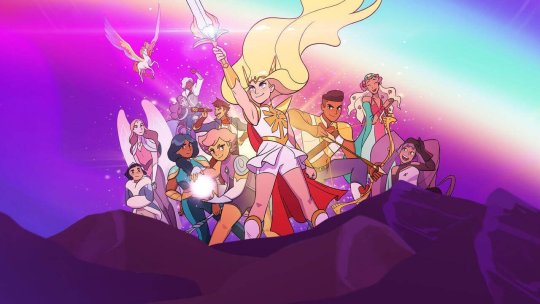
WARNING - THIS ANALYSIS CONTAINS MAAAAAJOR SPOILERS FOR THE ENTIRETY OF SHE RA!!
“You look out for me, and I look out for you. Nothing really bad can happen as long as we have each other”
She Ra is a show about two people torn apart. It’s important to recognise that this multifaceted masterpiece centres entirely on the Catradora dynamic; Noelle herself has expressed that the show was always about those two, and in a broader sense much of the wider world in the She Ra universe can be seen as a complex manifestation of Adora and Catra’s ever changing bond. Adora is not a hero in the traditional sense, as everything about her character is designed to subvert and deconstruct expectations of the hero’s journey. She is a powerful, strong and determined fighter with healing powers, a morally stubborn and highly empathetic person raised in a genocidal regime, and she runs away from the only home and only exponent of love she has ever known because her internal moral compass is just so intense it overrides the truest bond she will ever feel, at least until external factors allow for reconciliation.
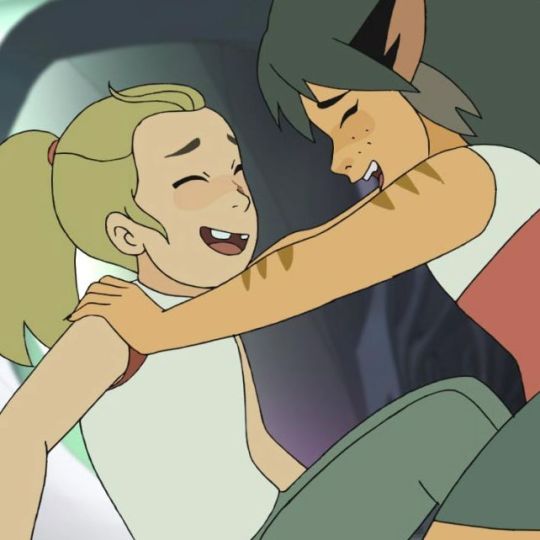
But what defines, at a thematic level, the human interactions in She Ra is a cycle of abuse that begins with oppressive control - Horde Prime. He punishes the imperfections in Hordak to the extent that Hordak feels compelled to lash out, to prove himself powerful by any means. Horde Prime is an interesting villain because his rhetoric centres not around darkness, but light and purity. This is not only a more subversive type of manipulative language than is often seen by cartoon villains, but it clearly establishes Horde Prime as being a fundamental representation of abuse and its tendency to beat away at character traits deemed weak, anomalous, or more importantly unable to be controlled. Horde Prime needs control; he needs subservience and pure, untouched power, which is why he forms his empire around a hive mind. Hordak of course breaks the hive mind itself, but abuse is a parasitic thing, and controls Hordak’s deplorable actions on Etheria right from his first introduction, talking directly to Catra. But the cycle does not stop at Hordak; his monstrous coping methods cause subtler damage by affecting Shadow Weaver. She is an interesting character because unlike Hordak, she was shown to have independent agency in her harmful actions before finding her way to the Horde, but it is clear that the intense sensation of being cast out, before the Horde rescued her only to thrust her into a cycle of rage and exploitation, leads to the final stage of this particular cycle: Adora, and more importantly Catra.

The show makes it abundantly clear that Catra gets the short straw in interactions with Shadow Weaver; and not only that, but it is shown that Catra’s narrative of Adora being a neglectful, selfish pretend-hero is one instilled not by Adora, but Shadow Weaver and her often-times violent favouritism. Adora isn’t selfish or neglectful - her strong moral compass certainly isn’t perfect, and letting go of complete undirected empathy is something she learns in the conversation with Mara in season 5 (“you are worth more than what you can give to other people”) - but those traits are at odds to how Adora is presented, and in particular how her relationship with Catra is presented. Shadow Weaver neglects Catra, and does it to such an extent that Catra is forced into a mindset of breaking her bond with Adora over an injustice that was never her friend’s fault. Shadow Weaver’s manipulation is so powerful, it makes Catra believe that Adora’s protection, her deep-seated love, is malignant. That is abuse: it turns love into hate and protection into violence.
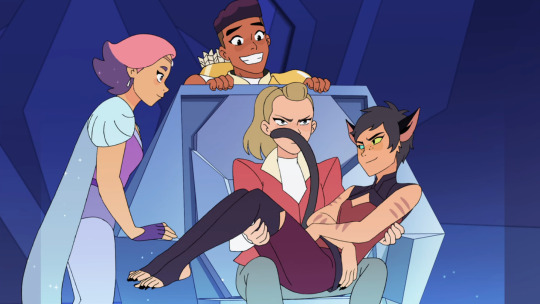
In this cycle, this systematic abuse from Prime to Hordak to Shadow Weaver to Catra, there are two anomalies. They have to be anomalous, uncontrollable, natural, because this cycle begins with oppressive control, and therefore only two variables can violate that base injustice - love, and imperfection. From a meta-narrative sense, She Ra is a unique beast because characters do not simply have flaws for the sake of flaws, but those flaws are the direct reason for the eventual collapse of the show’s main antagonism. What breaks Prime is a kiss, and a mad scientist. The kiss is Adora and Catra displaying a desire for closeness that represents years of struggle against systematic abuse, abuse that has deliberately forced love to become hate, and that only when the cycle reaches its peak and the initial abuser makes a final bid for absolute control, can the true reconciliation begin. The mad scientist is of course Entrapta, whose powerful adoration of imperfection ultimately destroys Prime, or at least his preferred vessel. Abuse of the kind shown in She Ra cannot exist when people find beauty and joy in the things it seeks to eliminate, and Entrapta is exactly the anomaly needed to help break the cycle. Returning to the core of those two lovers, Catra finds her want for Adora, and it is reciprocated because the underlying love was always there, but the intent, the desire for closeness only became apparent when years of unnecessary hurt had been recognised and their true cause exposed: not each other, but the cycle.
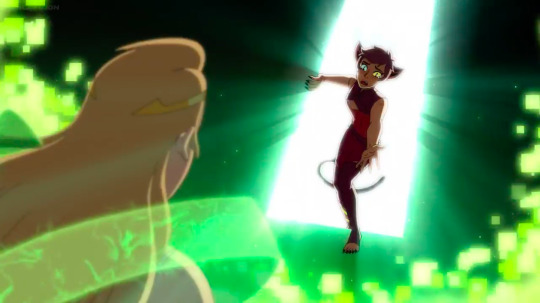
Of course, abuse in the She Ra universe is only actively broken by one thing: love. I touched on this theme earlier when discussing abuse as the two are somewhat intertwined but love, in platonic and romantic forms, is so crucial to the functioning of She Ra’s characters and their motivations. Catra and Adora have always loved each other (they only express this at the climax because they must fight through abuse to find a shared desire), and this love is shown right from both the start of the show, and the first time we see them interact chronologically - in Promise. What’s interesting is we never know how they meet, or what they say to each other first, but instead the earliest canonical Catradora interaction is the promise itself: a dedication so strong it defines Catra’s actions years later on an alien ship as she saves a person she does not even claim to like. The show puts Catra and Adora’s love first, as that is the establishment of their truly meaningful connection, with other flashbacks and all of season 5 expanding upon that bond. We know that love breaks abuse because Horde Prime is abuse and he is defeated by a kiss, but what does that imply?

The kiss, and therefore the confirmation of She Ra’s central love, carries with it a moral lesson, a message, that hurt and abuse can be overcome through the mutual reconciliation that comes with unconditional love. In the show, all kinds of love shown to be beneficial and non-toxic are unconditional: Catra can only want Adora when she accepts that Adora will always be morally upstanding and stubbornly empathetic, and Adora can only want Catra when she accepts that Catra defaults to self-hatred and pushing away, and only when both of these conditions are made meaningless by the force of attraction and belonging known as love, can the kiss be shown and the abuse broken.

Love is not just shown between that central relationship, but throughout She Ra and its characters. Glimmer is a flawed and sometimes maligned character, but her importance to the show and its progression cannot be overstated, especially in season 5. On the ship in episodes 1 and 2, Catra needed something to hold onto. Torn from her home, powerless and very clearly unable to manipulate and fight Horde Prime like she could with Hordak, Catra’s only option became Glimmer. Their bond forms quickly and shakily, but what is so crucial about their interactions is that in order to reconcile with Adora, Catra needed to see someone like Glimmer, who had both made huge mistakes and at one point believed her own mistakes to be the right decision, completely and unconditionally forgive Adora and desire to be home with her. They share love for Adora, different kinds of love, but a strong connection and belonging that in the case of the open and empathetic Glimmer is very obvious. It’s also no accident that later on, during interactions in the expanded Best Friend Squad, Catra takes several social cues from Glimmer first, with Adora a trusted support. Catra is always going to care about Adora more than anything, but it takes the model example of Glimmer to show her how.
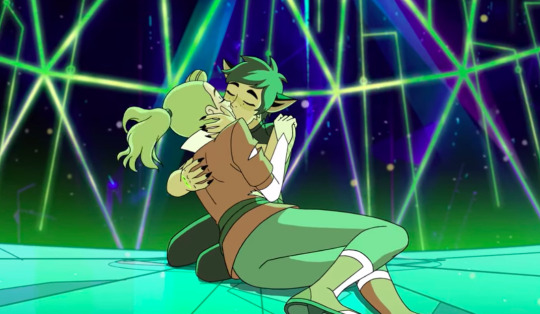
But Adora is not just the subject of Catra’s attractions. As the main character, the dual figure around which the show is built both emotionally and plot-wise, she has a striking amount of agency, but also experiences a corruption of her truest desires at the hands of abuse. The abuse of Adora is subversive and difficult to spot, but it all comes down the pedestal that Shadow Weaver built for her, as well as her own innate morals and how those two factors, in Adora’s mind, prevented her from loving and caring for Catra in the right way. Throughout the show, Adora treats her own need to help others and her desire to be with the people she loves as mutually exclusive; even when Bow and Glimmer remind her that she is not alone, Adora has a penchant for going it alone, believing herself to be this chosen hero who must rescue the people of Etheria without reconciling with herself and her closest friends. In fact, the part of Adora that pushes people away in the name of heroism is not actually her, but instead the cycle of abuse exploiting her moral compass to fulfill corrupt desires that are not and never could be her own. Even the purported good guys do it, the First Ones making Adora believe that her path, her destiny, is to be a weapon. She fights this at the climax of season 4, but never comes to terms with it mentally until the conversation with Mara. And after it has all become hopeless, lost and Etheria is destined to burn away, Catra flips the script. Adora’s truest desire was Catra, but the abuse was too ingrained, the hurt too deep, for these desires to become reality, to be found within themselves. Only when Adora knows her blind heroism has lost, and therefore all to be lost, can Catra, whose arc has now culminated, save the universe. They both found not only their own destiny, but learnt to accept the intertwining of their lives as something that can be a force for good, a force for love.
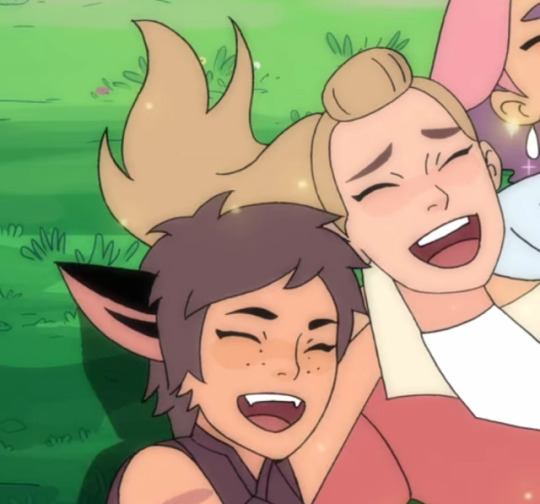
So to conclude, She Ra is not just about being torn apart, but in the end is about two girls fighting abuse as they learn to love each other, and eventually watching the patterns of abuse fade away as they express pure, unconditional love through a kiss that changes everything.
“Don’t you get it? I love you. I always have.”
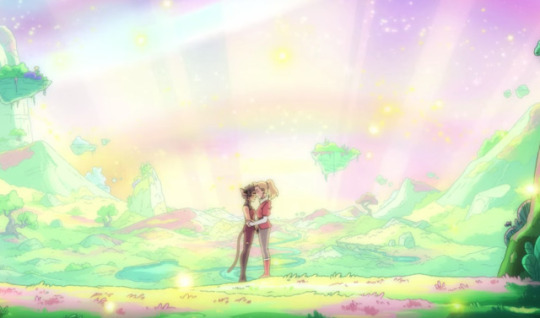
#spop s5#she ra#she ra analysis#adora#catra#god this was such a bitch to write#this show is so complex#lesbian#dyke#she ra season 5
20 notes
·
View notes
Note
Do you prefer Steph as Spoiler, Robin or Batgirl? (I like all three but in a pinch I think I like her as Spoiler the most)
This got very long! Sorry, but apparently Tumblr, being a functional website, won’t let me put this under a cut!
So like, in terms of my all-time favorite Steph characterization, I prefer her as Spoiler. My favorite Steph ever, of all time, is, without a doubt, Steph as Spoiler, as seen in Cass’s initial run as Batgirl. It’s home to some of the best moments of characterization, the foundation of her friendship with Cass, and just fundamentally broadened Steph’s character and rounded her out, more than her role in Robin ever managed to do, imo.
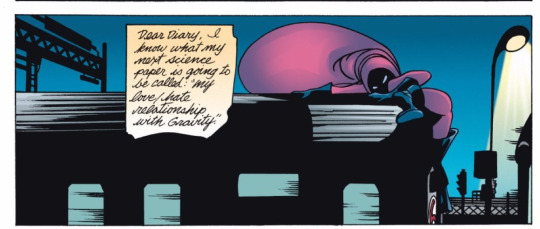
(Batgirl #20 - a classic)
Although, that being said, her Robin appearances in that run gave some stunning moments too. So maybe I should just give full credit to this creative team.
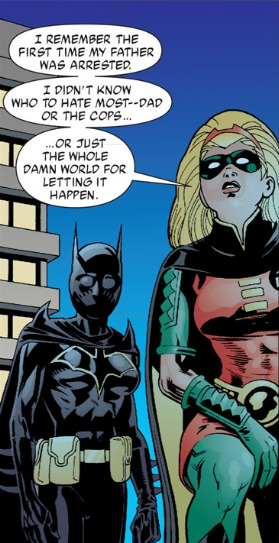
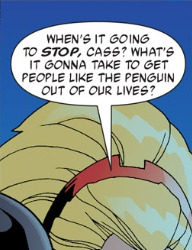
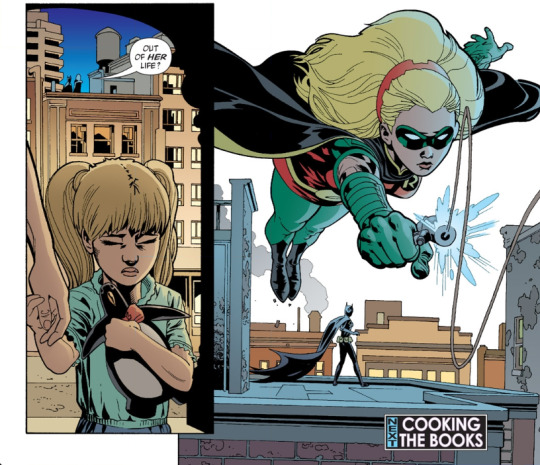
(Batgirl #53)
However, in terms of what I, if suddenly given control of a Stephanie Brown comic book, would write her as? And what I’d love to see more of her as?
Robin, hands down.
Steph just makes sense as a Robin. She’s deeply connected with Gotham City, her relationship with Bruce was turbulent and complicated. She has thematic similarities to Jason and Dick in turn, and, on the few occasions that she and Bruce were allowed to get along, they had a solid partnership.

(Batman: Gotham Knights #22 - insert that Adele gif here, please and thank you)
Steph and Bruce’s dynamic is under-explored and fascinating to me. Their push and pull of her looking up to him and being infuriated by him, him wanting to protect her by forcing her out of the game as part of his misguided grief for Jason (which is part of why I struggle with their dynamic in the Nu52, because so much of Bruce and Steph’s classic relationship was defined by Bruce’s grief) and his occasional recognition of her talents and wanting to foster them, could have been a truly fascinating Batman and Robin dynamic.

(Robin #92 - so much goddamn potential here, UGH)
Bruce finds himself unexpectedly being able to confide in Steph about things that he’s reluctant to talk about with the others. The two of them are virtually the opposites in terms of a lot of things, but both of them are drawn to Gotham as an idea, as something that needs protecting. Unlike pretty much every other member of the “core” Bat Fam, Steph and Bruce have never really been affiliated with any other city, and Steph hasn’t even been affiliated with another team. It’s not too far of a stretch to imagine that the two of them could bond over this, and their different perspectives on the city.
As Robin, Bruce was finally helping Steph full time; he was, as he said, teaching her. He was fostering her skills and talents, and helping her develop fully as a crime fighter. But as he was doing so, it highlighted Steph’s flaws as a character. Her anger, her self-righteousness, and her sheer stubbornness. It was a strong parallel to late-era (and post-retcon) Jason as Robin, but here, we managed to get glimpses of Bruce’s development, and how he and Steph could grow together.

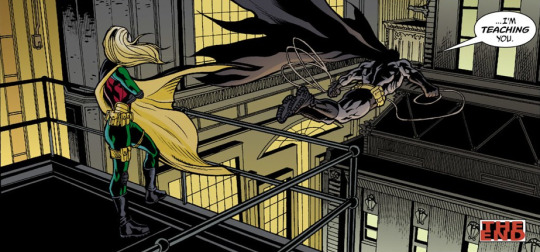
(Detective Comics #796 - the fact that this was technically published AFTER Steph did get fired only makes me more bitter)
But of course, no one was willing to give this relationship (or Stephanie) a chance. Steph was Robin for three issues of the classic Robin comic (with additional appearances in Batgirl and Detective Comics, including some that were printed after that last issue of Robin, because comics!). From her initial appearance as Robin in #126 (May 2004), to her final appearance in #128 (July 2004), we had Stephanie Brown as Robin for three months. It’s ludicrously underwhelming, especially given the amount of potential that Steph and Bruce had.
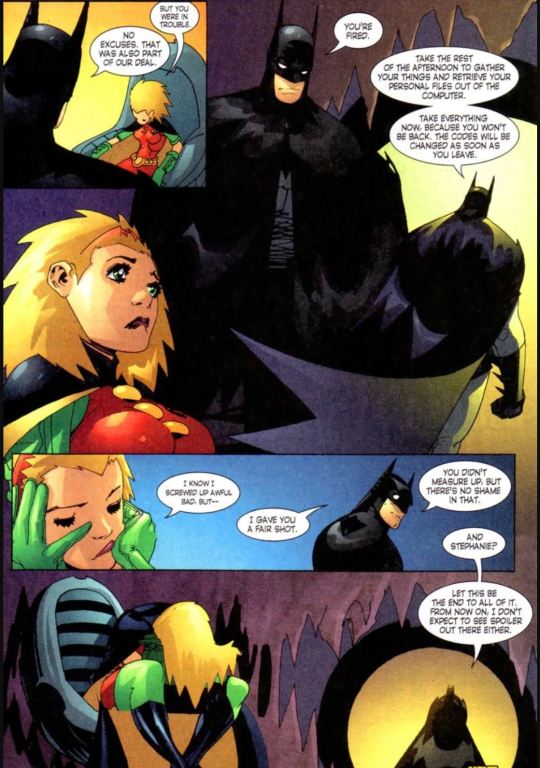
(Robin #128 - presented without comment and a lifetime of bitterness)
I genuinely believe that Steph’s dynamic with Bruce, connections with Gotham, and overall personality could have made her one of the best Robins, and that being Robin could have opened up some great opportunities for her character. Steph, unlike the rest of the Robins, never really got a chance to spread her wings and grow into the role, which is a damn shame, because I genuinely believe that she could have been great.
And so, if push comes to shove, I’d definitely go for her as Robin, although I do love her as Spoiler and Batgirl.
#steph reads comics#stephanie brown#bruce wayne#dc#bat family#anonymous#steph replies#asks#long post#steph writes steph (brown) meta#Steph vs The Bat Fam
342 notes
·
View notes
Note
Do you think there is some comparison to be made between the way Sugimoto and Asirpa join hands to help/reach each other and Ogata grabbing her hand in order to buy time for himself ?
It’s an interesting suggestion.
I take in regard to Sugimoto and Asirpa you mean this scene in which she pulls him up from under the bear and then they introduce each other?

The anime put a lot of emphasis on it in fact it’s worth to note this scene is inserted in the first opening...

...was inserted in the second opening the first time it was transmitted...

...only to be replaced with a longer version of this one...

...and we’ll see Sugimoto and Asirpa holding hands again in the dream in the last episode...

...as well as a flashback of the first episode.

It’s something that leaves a strong impression, isn’t it?
We saw it in the anime so many times I forgot in the manga is depicted differently...

...with Sugimoto and Asirpa both holding each other wrists instead than hands.
What looked like an handshake in the anime, in the manga is depicted as just a practical pulling up (Sugimoto has ended up stuck under the bear and asked Asirpa help to get out from under it, whcih she provided).
As much as the hold in the anime can seem cute, it’s too gentle and wouldn’t have managed to pull Sugimoto up. Actually it would be pretty hard for small Asirpa to pull up the much bigger and heavier Sugimoto with whatever hold but the hold used in the anime would prove expecially ineffective because it’s too slippery and not enough secure (not mentioning Sugimoto might end up hurting Asirpa’s fingers if he tighten his hold too much).
The anime went for that type of hold probably because it likely wanted to provide the image of a bond, a gentle, warm and loving one, which is why the imagery of joined hands is proposed so often it leaves an everlasting impression as well as... well, a handshake.
Skipping how the hold in the manga is more functional, it also gives visually an image of union, of joined efforts. Sugimoto and Asirpa will be partners, companions in this adventure, equals and strongly tied to each other... but also with Asirpa clearly pulling Sugimoto up. It can stand as a handshake since they introduce each other a moment after but it’s clearly not. Asirpa is pulling Sugimoto up, he’s relying on her.
So now let’s look at Ogata’s hold on Asirpa.

At first it might seems it looks nothing like the hold Sugimoto and Asirpa have when they first meet, be it the one used in the manga or the one used in the anime, although it has some elements in common with the hold used in the second opening...

...where Sugimoto is pulling Asirpa a lot more than Ogata (and this kind of hold is probably also uncomfortable for his shoulder compared to Ogata’s as he has to rotate his arm to keep it... LOL, the anime always chose pretty over practical in regard to holds... but well, again it’s a cute image that calls back to the hand holding of the first opening).

Back to Ogata and Asirpa’s hold, Asirpa is not returning it but it’s not like she can.
If we compare it with the wristholding Sugimoto and Asirpa performed, Ogata isn’t holding her wrist, he’s holding the lower part of her hand, his hand wrapped around it, through not overly tightly (the index finger is a bit loose).
Again it provides a better hold than just the handholding we see Sugimoto and Asirpa performing in the first episode of the anime (especially considering the smaller size of Asirpa’s hand) and it presents less risks to be painful should he thighten it (no squeezed fingers). Asirpa isn’t really resisting though, her hand isn’t clenched, but slightly open.
If we want a symbolic analysis of this hold it depicts how Ogata is afraid to lose Asirpa but that, while Asirpa is letting herself be pulled (Ogata is fundamentally pulling her, he’s much forward compared to her) she’s neither pulling him back or attempting to resist (her hand is relaxed, not clenched).
It’s the type of hold a parent can use with a child so as to make sure he won’t lose him when they’re in a crowd and he fears they could end up being parted (better grip but with less risk to hurt him), so it reveals anxiousness from the one who’s doing the hold (the hand wrapped around the child’s is a sign of protection).
It’s also worth to note Ogata could have tried holding her wrist, which would have probably been more uncomfortable for Asirpa but would have given him an even better grip, instead, despite everything, he went for the hand.
He doesn’t really want just to pull her, he’d like for her cooperation... but he clearly doesn’t know the way to go at it.
Asirpa is letting him hold her, but she’s not holding him back. She’s not afraid to lose him nor she can hold him or hold on him.
They’re clearly not a team on equal standing and while the underlining theme of the previous hold remain (Sugimoto needed Asirpa to pull him up, Ogata needs Asirpa to stay with him) the dynamics between them are clearly different.
It’s true though that Asirpa, after the earlier attempts at pressuring Ogata into doing something at the beginning of their travel together, had settled into a gentler nudging and giving him time to come along at his own pace, which in a way we might end up seeing here as well is Asirpa will manage to get him tell her all she wants to know.
It’s also worth to note it’s the first time Ogata is touching Asirpa.
We had seen Asirpa holding him, not so tightly but still touching him when they went on hunting the reindeers together and when they rode the sleights together or also when she checked if he was feverish or took care of him while he was but this, as far as I can remember, it’s the first time he touched her.
So yes, a comparison can be made and it might totally be it’s meant to be made. Or not but it was still fun doing it so thank you for suggesting it was possible to do one!
29 notes
·
View notes
Text
Analysis of the Lions and their Pilots
With the switch of Pilots in Season 3, I was wondering how the Lions choose their Pilot. Since the switch involves Black, Red and Blue, I’ll focus on those three. It’s rather Lance-centric I admit, because he’s my boy and the reason why I was thinking about this in the first place.
As a preliminary, it’s pretty clear that one main way the Lions select their Pilot is through a match of personality between them and their Pilot. However, I’m sure it goes beyond having a similar personality, given how Season 3′s switch doesn’t completely follow that pattern. The most obvious example for me was Black and Keith. As per Allura’s description of the Lions in the pilot episode, Black requires a pilot who “is a born leader and in control at all times, someone whose men will follow without hesitation”. Based on this description, absent Shiro, Allura would be the Black Paladin. Pidge even describes her as the “decision maker”. Yet, Keith, resident hothead, is who Black chooses. In fact, as the former Red Paladin, Keith would be described as “temperamental” and “unstable”. While one could argue that he had character development since the pilot episode (and I agree), I wouldn’t exactly describe someone who lost his temper at a diplomatic meeting in control of his emotions.

Even for Lance and Red, there is a difference in how they approach fights as well. Rather than relying heavily on instincts, Lance thinks through his actions before delving into them. He’s not fiery in battle to the same extent Keith is, choosing to attack at what he perceives to be the right moment instead.

In any event, it would be superficial if the “mystical bond” between Lion and Pilot was based on personality alone. Certainly, individuals do not require a similar personality to work with each other. Hence, beyond a personality test, I think the Lions look out for the candidate whom they can trust to carry out the nuanced roles played by the different Lions. This is based on a few observations - how Shiro had to compete with Zarkon to prove himself to Black on the metaphysical plain, how Keith and Lance had to prove themselves to Red (albeit in different ways). Additionally, trust is an important cornerstone for any relationship, what more a strong mystical bond. Hence, while a similar personality fit is an ideal situation for the smoothest teamwork, if a Lion ultimately feels that she can trust a particular Paladin despite some differences in working styles, I believe that concessions can be made.
The question then is how the Lions decide whom to trust.
I’ll start with Red. For Red, I think the lion’s nuanced role is supporting Black. As mentioned by Allura to Lance in Red Paladin, Red accepted Lance when he “proved that [he] valued a strong team over [his] own need for glory”. Similar to Alfor, Lance was able to set aside feelings of pride in order to support someone else as the leader. As neatly phrased in Lance’s Voltron Wikia page, Red takes a pilot who is capable of being “a trusted right hand, putting the power to command in the hands of a great leader in battle, giving his assistance where it is needed, and stoking the fire for his friends“.
However, if it was simply a matter of being willing to be the right hand of the leader, it doesn’t explain why Allura wasn’t selected. Rather, I think the edge Lance has over Allura is because of his relationship with Keith. In my opinion, the Red Paladin has to be someone who not only sincerely supports the Black Paladin, but whom the Black Paladin sees as their second, because trust has to go both ways. One cannot be a self-proclaimed right hand. Looking at Season 3, Keith saw Lance as a second-in-command, whether consciously or not. While the rest of the team did congratulate Keith, it had been Lance’s words that pushed him to accept his new role. Objectively, this makes sense, given how they have worked together as a pair and make a good team when they put their minds to it.
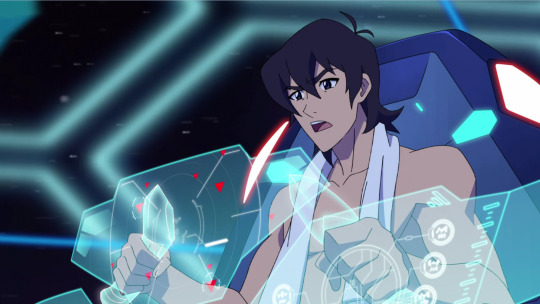
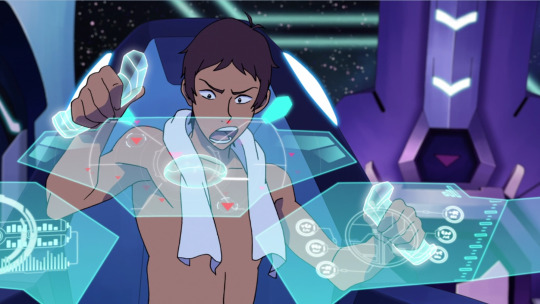
Not only do they have a good dynamic, Lance has also reined Keith’s rashness in battle.

As much as Keith sees Lance as a “goofball”, he should know that Lance is someone who is skilled to make quick and smart decisions in the heat of battle.

As a new leader who doesn’t trust his own ability to lead, I can see how he would at least subconsciously view Lance as a second to support him. Similarly, Shiro likely viewed Keith as his second-in-command, as evidenced from how he told Keith to step up as the leader should he fall.

(*cue cute hugging scene*)

For Blue, I see her almost as a Jack of all trades, capable of holding her own in both defence and attack. She plays a support role which requires flexibility in order to “[provide] what’s needed at the time” (Mitch Iverson’s explanation from the Let’s Voltron podcast). Indeed, as the legs of Voltron, Yellow and Blue both provide greater overall support functions than Red and Green (I don’t count Green’s cloaking ability as that was added by Pidge, and not part of the original lion). However, Yellow differs from Blue by taking a greater defence function, such as armour and anchoring. Blue’s support function is more fluid, where she has a diverse set of weapons for attack and support, providing what’s needed in as many different situations as possible. For example, her Sonic Cannon, other than being used as an attack weapon underwater, has a support function via echolocation and mapping. Undisputedly, this has been a crucial weapon, as seen from episodes Escape from Beta Traz and The Hunted.
Blue recognised the capability of playing a flexible support role in Lance and Season 3 Allura. For Lance, one example of how this capability was reflected is the form his bayard took. Beyond his natural sharp shooting abilities, his Blue bayard was an energy rifle, flexible as a long and short ranged weapon. Given how the bayard complements the Paladin’s fighting skill and style, Lance’s rifle reflects his fluid fighting style. Other than his bayard, his flexibility in fighting style is also shown through his situational awareness, where he is quick to adapt his tactics in view of different environments.


Additionally, Lance is the sort of person who looks out for his team, even if he isn’t especially close to them. For example, he instinctively jumped to cover Coran once he realised “Rover” was a fake. In that split second, his decision was not to cover himself, but to cover an alien he just met.

This character trait was likely especially significant at that time of the pilot episode, as Blue needed a Pilot who would stand by a new team they hardly knew. Fundamentally, Lance is that type of person. Similarly, Season 3 Allura showed that same drive to support the team in any capacity she could. At the Red Paladin episode, she expresses, “how can I allow others to risk their lives in battle and not be prepared to do so myself? I must try”, “others are risking their lives in this fight and I can't continue to ...”
Although Black’s role seems the most obvious - “the decisive head of Voltron”- it was more difficult for me to pinpoint how Black chooses its Pilot. I didn’t understand why Keith was chosen as the leader over Allura. Not to say that Keith isn’t a born leader as well, because he is. He just appeared less ready to be the leader, compared to Allura.
To me, one huge edge Keith had over Allura was that Shiro had chosen Keith as his successor. With that, I think Black’s relationship with her Pilot runs on a deeper level than the relationship the other Lions have with their Pilots. She keeps that deep bond with her former Pilot unless the circumstances are exceptional, and because of that bond, she takes her former Pilot’s decision into account. One example of how deep the bond runs was Black’s bond with Zarkon, where Zarkon could continue to commune with Black, despite Black’s simultaneous strong bond with Shiro (as evidenced from Shiro’s successful blind dive which “is an expert level drill that [one] really shouldn’t be attempted unless [one’s] been flying for years”.)

It showed how Black remained loyal to her former Pilot, even as her former and current Pilot fight against each other. Zarkon’s commune only stopped when Shiro won Black’s trust and respect completely by proving his respect for her sentience (after being thrown around like a rag doll and almost dying).

Hence, although Allura was an equally worthy leader, Shiro’s choice ultimately led Black to choose Keith, to trust Keith as Shiro did.
SO, that’s me trying to rationalise why the Lions made the choices they did. As Allura explained, “The quintessence of the pilot is mirrored in his lion”. Other than personality, I think it boils down to how much the Lions trust a particular Paladin, which partly depends on the relationships between different Paladins.
91 notes
·
View notes
Text
Gender Complementarity in Bedouin Society
This is an exploration of the idea of gender complementarity in Bedouin society and its relation to public and private life, as depicted by Abu Lughod in Veiled Sentiments.1 Firstly, an argument is presented about why such a topic should not be disregarded as anti progressive, despite how it might not fit with the gender equality doctrine. Also a brief consideration of how it already takes place in western culture. In order to understand the subject in Bedouin society a claim is made of what the existence of gender complementarity implies and is follow by an argument of why it is essential to understand it in terms of the Bedouin’s values. Then a brief description of the value system as it relates to men and women before addressing kinship, marriage and the ghinnāwa and how they express the presences of a complementary relationship between genders.
In this western society where we are focused on achieving gender equality, the idea of gender complementarity could easily be construed as a backwards way of thinking. Dividing a group up by its biological markers such as gender or race before delegating roles to individuals based on their group identity has been a common story of history. This phenomenon has too often been the justification for the suppression of one group by another, for their own gain. But the idea of gender complementarity is essentially the opposite of oppressor/suppressed dynamic typically used to describe male/female relations throughout history. So while gender complementarity is at odds with gender equality, to dismiss it as backwards would be a disservice to men and women alike. Given that irrefutable differences exist between biological sexes, such as reproductive organs, a case could be made that Gender equality is a utopian vision which would ultimately confine both genders to be each other, rather than free to be themselves. Regardless, males and females are reproductively depended and need one another. One option is to exist in a complementary relationship, where each gender is able to specialise in a strength, while being supported by the other where it is weak. In the west this exist most commonly between individuals in the form of marriage, where two individuals unite together despite their differences and aim for what’s good for both of them, not just for themselves.
In Bedouin society however, this complementary relationship isn’t only between married individuals but permeates the whole culture. To understand how such as thing as gender complementary can exist on a societal level, it is important to recognise that it is reliant upon a unified recognition of a transcendent ideal. This is to say men and women must subordinate themselves to something that transcends their own group’s needs and wants, and unites them with the other. So when addressing the idea of gender complementarily in Bedouin society it must be in terms of their own ideals, not ours. “Blood” is a central idea to Bedouin people as they consider themselves decedents of the first followers of the prophet Muhammad.2 They identify so strongly with their blood that it’s believed that their morality and character is drawn from their male descendants.3 Abu-Lughod described this supposed inherited morality as being centrally defined by honour and modesty.
“Individuals must achieve social status by living up to the cultural ideals entailed by the code of honor, in which the supreme value is autonomy.”4
Autonomy is central to the code of honour and it is a key determinant to where one falls on the social hierarchy.4 The code of modesty is an alternative for those who are weak and dependent, unable to realise their autonomy.4
“Awlad ʿAli mediate the contradiction between the ideals of equality and the realities of hierarchy by considering relations of inequality not antagonistic but complementary. They invest independence with responsibility and a set of obligations and dependency with the dignity of choice.”5
Here Abu Lughod eloquently portrays the essences of the complementary relationship between genders for Awlad ‘Ali. Men, the “strong”,6 are valued and respected by society to the degree that they use their own autonomy, to choose conformity to the honour code. This entails a responsibility to protect and care for their dependants; “inherent in the division between weak and strong is a unity of affection and mutual concern”.6 For Women, the “weak”,6 which are always dependent to some degree, validate the honour of their provider through voluntary submission.7 This voluntary choice to act with modesty is a demonstration of autonomy and consequently is respected.8 This also implies that involuntary subordination to the strong reflects negatively on both parties. Here in the cultural distinction of men and women of independent and dependent respectively, causes a separation in the domain of which each group primarily operates.
The code of Honour is best represented in the public sphere and is done so by men.5 Women who thought to be morally inferior are more restricted in their movements and operate primarily in the private sphere.9 Abu Lughod recalls version of the fall from grace told by a man of the group.
“God created Eve from Adam’s bent lower rib. That is why women are always twisted. They never talk straight.”9
This clearly illustrates a relatively uncontested opinion that men are more capable of bringing the code of honour to life in Bedouin society. Thus men subordinate themselves to the transcended ideal of the honour code, while women subordinate themselves to honour code in the form of man by practicing the modesty code. Both benefit by being able to live in a more honourable society. But dividing the roles of men and women so contrastingly means a system must be in place to maintain that divide and also to stop it from becoming divergent. The Strong’s identification with their kin strengthens the ties between sexes, just as unification can occur under an ideal, it can also occur over shared descendants. The value the Bedouin attribute to blood and their orientation towards honour is portrayed clearly in preference of the marriage between a man and his father’s brother’s daughter.
“The advantages of such marriages are that they presumably build on the prior bonds of paternal kinship to take on the closeness, trust, identification, and loyalty appropriate to such bonds.”10
Kinship also strengthens bonds between men, which simultaneously creates distance from women. The emphasis on patrilineage, men’s moral superiority to women and consequent responsibility to maintain honour in the family, reinforces the distance between genders.9,11 Similar can be said for women who share the social expectations of modesty.12 But there is a sacrifice entailed in conforming to the codes of honour and modesty. The ghinnāwa is a beautiful example of a medium that straddles the dichotomy of separateness for unification, by recognising the hardship of being part of something that transcends your own desire.
The ghinnāwa or little songs, are forms of spoken poetry that express sentiments of weakness, that if spoken in the standard medium of communication would be considered a failure to uphold the honour or modesty code. Abu Lughod portrays this clearly with a poem composed by a man that expresses his feeling of heartbreak, when recalling a woman he had love but married another man.
“Thinking of them with pain if only they would not come to mind . . .”13 tafākīrhun bawjāʿ lū kān mā ʿalēnā yukhuṭrū
Poems such as this convey deep personal feelings but provide no imbedded context to attach what is spoken to the speaker, allowing them to share their own hardship in a creative, artistic and thoughtful manner without diminishing there moral worth.14 The ghinnāwa are not spoken between men and women except as lovers, but both share poems with their own close groups.15 This creates a stronger connection between men and women at the level of individual lovers, but creates distance at the group level due to the private and confidential manner in which they are shared. This is best understood by Abu Lughod's comparison of these sentiments to secrets. “Secrets function to exclude those who do not share them and to closely bind those who do. Thus, categories of equals gain cohesion and divisions between nonequals are intensified, reinforcing the structures of Bedouin society.”16
So while the ghinnāwa seems contradictory to the codes of honour and modesty, there is also an element of a complementary relationship.
The idea of gender complementarity in Bedouin society is fundamentally about the division of values; Honour and Modesty. This translates in the public and private spheres where men portray honour publicly, through strength and independence where as women portray modest privately, though self-control and wilful submission to whom they depend on. This is a dichotomy because it implies honour is the highest ideal, but that honour with modesty is more honourable. Similarly, independence is a crucial part of honour, but independence without any dependants is not as honourable as independence with wilful dependents. Marriage also is a dichotomy because men and women are separated as groups but unite as individuals. The ghinnāwa also serves to distance and reinforce social boundaries while strengthening the links between them. Everywhere one looks in Bedouin society contradictions arise that have a complementary relationship. To explain the public and private divide with the idea of gender complementarity would miss the point, because they are both a product of same cause.
In conclusion it must be noted that the focus here has all been on complementary aspects of gender in Bedouin society, with no attention given to the more antagonistic elements, which most certainly exist. This has been done in the hope of inspiring a more inquisitive eye, when cast upon a culture that is so contrasting and to open the doors to realising what the West might be missing. In Veiled Sentiments, Abu Lughod beautifully reveals a deeply embedded dichotomy at the heart of the Bedouin culture. Such a discovery leaves us to question if the practice of things such as gender complementarity, is the result of an archaic ideology or an honest cultural expression of human nature?
Reference List
L. Abu-Lughod, Veiled sentiments, University of California Press, 1986, Kindle ed., p.1, accessed 5/09/2019.
0 notes
Text
Why Values Are Important in Business
You may think that business and values do not have much in common. Perhaps business seems directly functional, while values seem to have to do with personal perspectives and cultural background. However, values are incredibly important to how businesses operate with their partners and their clients – whether the outfit is an auto mechanic in Boulder or any business.
Why is it important for a business to have values?
Ethics is not just important to the consumer or to affiliates of an organization but to an organization itself. In fact, W. Michael Hoffman has pointed out in risk assessment publication Corporate Compliance Insights that lack of values actually increases the risk of a firm. Here are a few key reasons why business management should be values-driven:
Pressures of the market – When you have to find ways to cut costs, you may not have as many checks and balances in place to maintain proper behavior. Employees might have their own ability to act one way or another, leading to possible ethical violations.
Diversity – In the United States, there are people interacting with different genders, religions, and ages. This diversity leads to different perceptions of what it means to act professionally within a business. While there must be commonly understood codes of conduct, the way that a person comprehends the exact same scenario and information can be very different from another person’s based on their demographic characteristics.
Globalization – People from various cultural backgrounds will not all experience different situations and circumstances the same. In certain cases, ethics becomes confusing related to the issue of culture, in which case the issue is sometimes considered a cultural sensitivity rather than a simple ethical precept.
Remote workers – Since so many people are working from a distant location part or all of the time, it is important to have values that infuse the organization at the management level.
Business partnerships – Your alliances with other businesses are another area in which ethical errors might occur. Values-driven tactics are effective not just at defining the ways that interactions occur internally but with external partners as well.
Team structure – There is more of a communal, integrated, team-based notion of internal growth in business today, with merit and individual aptitude leading the way to decision-making. Removing the top-down nature in which decisions have traditionally been generated has allowed all players to feel part of the process.
Entrepreneurship & intrapreneurship – Often now, companies are advocating that members of their staff, even at the entry level, become more innovative, try tactics (within structured confines) that embrace risk, and even get to use some funding. This method, called intrapreneurship, gives anyone working at a business a chance to feel like they are the owner and assume the relevant responsibilities.
Key values within a business setting
The above elements of business tell us reasons that values are important to business. However, what exactly are we talking about? What are the most common business values?
Here are some of the top values that are used by the world’s best businesses, according to responses to a questionnaire conducted by the Stanford Graduate School of Business. Alumni of the Stanford business school were asked to list the values that were most critical within a business setting. Here are a few key values, along with the comments that were made by those who responded.
Golden rule treatment – Wealthfront CEO Andy Rachleff noted that he thinks the golden rule is a fundamental precept of a solid business interaction. When a person approaches others with respect and with a goal of making a strong impression in a business setting, typically the favor will be returned. You will not only gain credibility but will also have greater peace-of-mind. You can put yourself at risk by acting in a manner that assumes mutual concern; however, even if you do get hurt occasionally with this strategy, you can simply discontinue your engagement with anyone who does not treat you in kind.
Integrity – Approaching your communications with all parties from a perspective of consistency and authenticity will point you in the right direction, according to Pagatech cofounder Jay Alabraba. Taking this honest approach will mean that you are not deceiving anyone or scamming them. In other words, you want to transparently convey what you are offering to everyone, regardless whether it hurts your immediate profits. University Games CEO Bob Moog also mentioned this value as a high-priority one in a business setting, noting that he had many handshake deals with other businesspeople, resulting in beneficial relationships that had lasted decades.
Straightforwardness – People often want to see a person who is going to talk with them directly and straightforwardly, advised Thought Leadership Lab CEO Denise Brosseau. Often people will want to work with startups or other organizations outside of Wall Street since smaller and less traditional companies can often have a greater degree of directness. This direct dynamic is aligned well with entrepreneurialism and the notion of getting to hand-select the partners through which one conducts business, said Brosseau. In that capacity, a company is able to not only offer straightforwardness itself but be able to filter for that quality in its clientele.
Mutuality – Tiny Prints co-founder Laura Ching noted that trust is built into a company that creates a familial, open-communication environment. When firms look for new employees, they can specifically have a desire to hire people who care about the strength of their bonds with others. The culture of an organization can also further enforce and enhance the notion that interconnection is critical to the mission of the company. People should be able to get courtesy from one another, but also friendliness. In that type of setting, people will feel comfortable to get even better at interacting with their peers. Loyalty and retention can both be high with employees and, in turn, with customers; after all, your clients become attached to certain members of your staff. When there is an implicit sense of honesty and having one another’s best interests at heart, you are able to acquire feedback that would otherwise be challenging to attain.
Transparent messaging – When a company has many different projects occurring at the same time, conducted by a broad array of players, there can be a huge range in the perspectives – leading, potentially, to communication difficulties between different projects that are ultimately interrelated. Empowered Careers CEO Steve Poizner commented that executives at companies should promote a business culture for which truth is critical to all interactions, regardless of all other factors. Additionally, said Poizner, being strong and unafraid allows someone to make the kind of impact they want with their customers and in their community.
Gratitude – We all want to be appreciated by businesses when we give them our money and invest in a relationship with them. As indicated by Ariat International CEO Beth Cross, organizations should remember that their clients care to know that they are appreciated.
Simple value – You can find out what the client needs in various ways, as noted by Design Within Reach founder Rob Forbes. Whether you use market research or simply release your offering to the market, you would be wise to think in terms of what the customer would actually value. By creating products that are high-quality and then communicating their story to your customer, you are able to give something to others through a business context that is authentic and can improve their quality of life.
Passion – Passion is another of those terms that may seem to be antithetical to the dry and serious needs of business. However, you really do want to care about what you do for a living – and be able to say the same about the people from whom you buy your goods and services.
An honest Boulder auto mechanic
It helps to get an idea of why values are important to business, and the specific values that should be high-priority for organizations. How can this search for values be reflected in your choice of car mechanic? We originally started Independent Motors because we felt our city needed an auto repair shop that was more in line with Boulder’s values – Community, Loyalty, and Honesty. See Our History and Beliefs.
from Car Care Tips https://independentmotors.net/values-important-business/
0 notes
Text
Seven Tips for Stepfamily Success
The stakes are high in marriage for those looking to get it right the second time around. While remarriage can heal the scars of divorce and blended families can provide newfound hope and optimism, recent statistics show that over 60% of second marriages fail. As ominous as this sounds, there are key steps you and your partner can take to maintain a happy remarriage.
In his book Stepfamilies, James Bray found that at the heart of every well-functioning blended family is a stable and happy marriage, and research by The Gottman Institute found that the strength of a couple’s relationship ultimately determines the family’s success.
Remarried couples need a strong foundation of trust and communication in order to buffer the challenges that arise from stepfamily life, and with the understanding that marriage satisfaction determines stepfamily stability, a loving and well-adjusted stepfamily is possible when couples commit to taking the time and action necessary to get there.
These helpful tips provide a guide for couples who are navigating the ups and downs of remarriage.
Set Realistic Expectations
Couples can become disillusioned quickly when they fail to anticipate the number of difficulties unique to stepfamily life. Caught up in love and having a sense of family once again, they can forget that blended families are not a restoration of what once existed, but rather a brand new construction of family life.
Once blended families face key issues head-on like finances, stepchildren dynamics, and navigating relationships with ex-spouses, then they can create the right atmosphere for a new family to grow and blossom.
Communication Is Key
It is critical that remarried couples learn how to communicate effectively and not be afraid to discuss sensitive topics as they arise. Conflict is inevitable, and without the fundamentals of effective listening and understanding, a couple can become gridlocked on major marital issues.
Over time, poor communication can chip away at the foundation of the relationship – the foundation that keeps the stepfamily intact. Gottman’s research found that 69% of conflict is unsolvable; there is no magic cure to eradicate the inevitable. Instead, couples should seek to manage conflict with empathy, compassion, and understanding.
Gottman also warns couples against engaging in the four most destructive relationship behaviors, known as The Four Horsemen, during disagreements (criticism, contempt, defensiveness, and stonewalling). Using “I” statements to express your feelings and needs, accepting responsibility, staying respectful, having gratitude and appreciation for your partner’s positive traits and actions, and being able to take a break when things get tough are all helpful ways to keep arguments from escalating and to avoid these behaviors.
Parent Together, Not Separately
Loyalty to your own child is real and valid, and can feel very strong. This can make stepparent discipline a very delicate topic. Remember that love and trust develops over time between stepparents and stepchildren. It’s important to establish roles for parenting and discipline early on and adjust as needed to each child’s developmental cycle.
According to Bray, the adolescent period of a child’s life can be a very difficult phase in stepfamily development – one that usually catches the couple off guard and can cause great strain to the family dynamic as a whole. Be mindful of this time in your own family structure, and engage in what Gottman calls “emotion coaching” to help adolescent children understand their emotions and to show that you’re there for them.
Create Your Own Unique Family System
One way to think of the difference between blended and nuclear families is that blended families are like a crockpot meal, while nuclear families are like a quick skillet sauté. Purely biological families are seared together with fierce devotion and love, yet stepfamilies stew together slowly, taking time to bond and become unshakeable.
Bray’s research found that stepfamilies often don’t feel like a unit until several years after formation. Give yourselves time to come together and develop as a family. You can help this process along by establishing some special family traditions like a weekly pizza and movie night or a monthly outing to your family’s favorite restaurant. Shared experiences like these can help families bond and form their own unique identity.
Stay Connected to Your Partner
Staying true to your shared goals as a couple and supporting each other’s future hopes and dreams is essential for staying unified. Daily check-in conversations, engaging in shared hobbies and interests, and regular date nights away from the kids helps to keep the relationship strong, romantic, and deeply connected.
Practice Patience and Understanding
The blending of families is like a marathon, not a sprint. Commit to the journey and find ways to enjoy and learn from each moment of happiness and frustration that comes with it. Did your stepkids tease you for winning again during family game night? Tease them back and keep it lighthearted. Did your partner go against your wishes on discipline? Talk it through honestly, calmly, and respectfully. With every slip up or misunderstanding, keep in mind that you’re both on the same team.
Stay the Course and Don’t Give Up
When things don’t go as planned or you’re having a difficult time integrating as a family, think back to the beginning and remember why you came together in the first place. No relationship is without its own set of challenges. Couples who commit to overcoming the obstacles together build a strong foundation to get through tough issues in the future. Supportive statements like, “This is a rough time for us, but we’re going to get through it” or “We’re in this together no matter what” can provide powerful motivation.
Remarried couples committed to success do best when they understand the importance of having a strong marital relationship that acts as the foundation for the blended family’s happiness. Marriage, including its challenges, can be a wonderful adventure for you, your partner, and your new family.
If want to build a deeply meaningful relationship full of trust and intimacy, then subscribe below to receive our blog posts directly to your inbox:
More in The Archives
http://www.successwize.com/seven-tips-for-stepfamily-success/
0 notes
Text
Seven Tips for Stepfamily Success
The stakes are high in marriage for those looking to get it right the second time around. While remarriage can heal the scars of divorce and blended families can provide newfound hope and optimism, recent statistics show that over 60% of second marriages fail. As ominous as this sounds, there are key steps you and your partner can take to maintain a happy remarriage.
In his book Stepfamilies, James Bray found that at the heart of every well-functioning blended family is a stable and happy marriage, and research by The Gottman Institute found that the strength of a couple’s relationship ultimately determines the family’s success.
Remarried couples need a strong foundation of trust and communication in order to buffer the challenges that arise from stepfamily life, and with the understanding that marriage satisfaction determines stepfamily stability, a loving and well-adjusted stepfamily is possible when couples commit to taking the time and action necessary to get there.
These helpful tips provide a guide for couples who are navigating the ups and downs of remarriage.
Set Realistic Expectations
Couples can become disillusioned quickly when they fail to anticipate the number of difficulties unique to stepfamily life. Caught up in love and having a sense of family once again, they can forget that blended families are not a restoration of what once existed, but rather a brand new construction of family life.
Once blended families face key issues head-on like finances, stepchildren dynamics, and navigating relationships with ex-spouses, then they can create the right atmosphere for a new family to grow and blossom.
Communication Is Key
It is critical that remarried couples learn how to communicate effectively and not be afraid to discuss sensitive topics as they arise. Conflict is inevitable, and without the fundamentals of effective listening and understanding, a couple can become gridlocked on major marital issues.
Over time, poor communication can chip away at the foundation of the relationship – the foundation that keeps the stepfamily intact. Gottman’s research found that 69% of conflict is unsolvable; there is no magic cure to eradicate the inevitable. Instead, couples should seek to manage conflict with empathy, compassion, and understanding.
Gottman also warns couples against engaging in the four most destructive relationship behaviors, known as The Four Horsemen, during disagreements (criticism, contempt, defensiveness, and stonewalling). Using “I” statements to express your feelings and needs, accepting responsibility, staying respectful, having gratitude and appreciation for your partner’s positive traits and actions, and being able to take a break when things get tough are all helpful ways to keep arguments from escalating and to avoid these behaviors.
Parent Together, Not Separately
Loyalty to your own child is real and valid, and can feel very strong. This can make stepparent discipline a very delicate topic. Remember that love and trust develops over time between stepparents and stepchildren. It’s important to establish roles for parenting and discipline early on and adjust as needed to each child’s developmental cycle.
According to Bray, the adolescent period of a child’s life can be a very difficult phase in stepfamily development – one that usually catches the couple off guard and can cause great strain to the family dynamic as a whole. Be mindful of this time in your own family structure, and engage in what Gottman calls “emotion coaching” to help adolescent children understand their emotions and to show that you’re there for them.
Create Your Own Unique Family System
One way to think of the difference between blended and nuclear families is that blended families are like a crockpot meal, while nuclear families are like a quick skillet sauté. Purely biological families are seared together with fierce devotion and love, yet stepfamilies stew together slowly, taking time to bond and become unshakeable.
Bray’s research found that stepfamilies often don’t feel like a unit until several years after formation. Give yourselves time to come together and develop as a family. You can help this process along by establishing some special family traditions like a weekly pizza and movie night or a monthly outing to your family’s favorite restaurant. Shared experiences like these can help families bond and form their own unique identity.
Stay Connected to Your Partner
Staying true to your shared goals as a couple and supporting each other’s future hopes and dreams is essential for staying unified. Daily check-in conversations, engaging in shared hobbies and interests, and regular date nights away from the kids helps to keep the relationship strong, romantic, and deeply connected.
Practice Patience and Understanding
The blending of families is like a marathon, not a sprint. Commit to the journey and find ways to enjoy and learn from each moment of happiness and frustration that comes with it. Did your stepkids tease you for winning again during family game night? Tease them back and keep it lighthearted. Did your partner go against your wishes on discipline? Talk it through honestly, calmly, and respectfully. With every slip up or misunderstanding, keep in mind that you’re both on the same team.
Stay the Course and Don’t Give Up
When things don’t go as planned or you’re having a difficult time integrating as a family, think back to the beginning and remember why you came together in the first place. No relationship is without its own set of challenges. Couples who commit to overcoming the obstacles together build a strong foundation to get through tough issues in the future. Supportive statements like, “This is a rough time for us, but we’re going to get through it” or “We’re in this together no matter what” can provide powerful motivation.
Remarried couples committed to success do best when they understand the importance of having a strong marital relationship that acts as the foundation for the blended family’s happiness. Marriage, including its challenges, can be a wonderful adventure for you, your partner, and your new family.
If want to build a deeply meaningful relationship full of trust and intimacy, then subscribe below to receive our blog posts directly to your inbox:
Email*
Name
This field is for validation purposes and should be left unchanged.
jQuery(document).bind('gform_post_render', function(event, formId, currentPage){if(formId == 26) {if(typeof Placeholders != 'undefined'){ Placeholders.enable(); }} } );jQuery(document).bind('gform_post_conditional_logic', function(event, formId, fields, isInit){} ); jQuery(document).ready(function(){jQuery(document).trigger('gform_post_render', [26, 1]) } );
The post Seven Tips for Stepfamily Success appeared first on The Gottman Institute.
from Meet Positives SM Feed 5 http://ift.tt/2zdekOO via IFTTT
0 notes